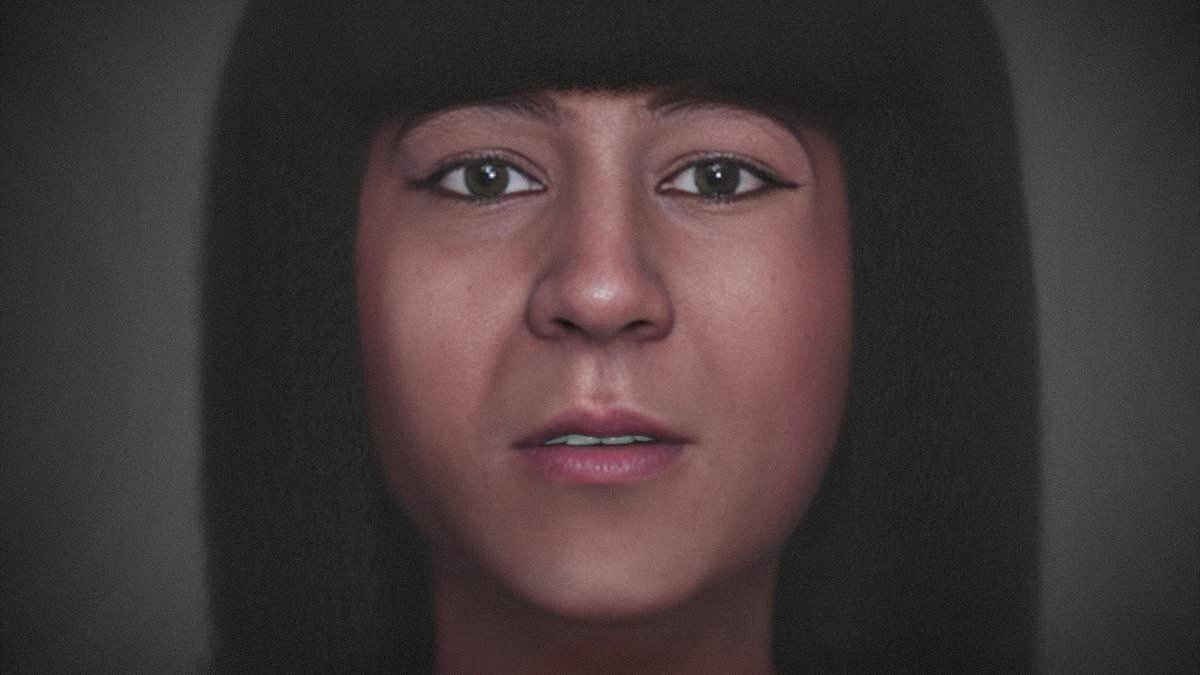The ‘elegant’ face of an ancient Egyptian priestess whose singing was said to be able to calm the gods can be seen for the first time in 2,800 years.
Meresamun had a role of ‘high religious prestige’ in the inner sanctum of the temple at Karnak before she died in mysterious circumstances.
Buried in a luxurious coffin, her mummy was purchased in 1920 by American archaeologist James Henry Breasted, and never opened.
Now her living face can be seen for the first time since the iron age, after CT scans were used to peer inside her wrappings.
Cicero Moraes, lead author of the new study, used scan data from the mummy’s skull to recreate Meresamun’s likeness.
‘She looks elegant,’ he said.
‘The reconstruction presents a harmonious and serene face, with features that suggest dignity and gentleness.
‘While any aesthetic interpretation involves a degree of speculation, the goal was to maintain a respectful image aligned with the deceased’s social role.’

The ‘elegant’ face of an ancient Egyptian priestess whose singing was said to be able to calm the gods can be seen for the first time in 2,800 years

Meresamun (pictured in her coffin) had a role of ‘high religious prestige’ in the inner sanctum of the temple at Karnak before she died in mysterious circumstances
The mummy’s elite status in life is revealed by her coffin.
An inscription on the front gives her name as Meresamun and says she was a ‘singer in the interior of the temple of Amun’.
Amun was one of the principle gods of the Egyptian pantheon, and the priestess’ esteemed place in his temple is reflected by her name, which translates as ‘Amun Loves Her’.
The coffin itself is richly decorated with many colours and symbols.
Mr Moraes said: ‘The quality and decoration of the coffin, as well as her religious role in an important temple, suggest that Meresamun belonged to the Theban elite.
‘Access to such an elaborate burial is consistent with high social status and significant resources.’
Oxford’s Ashmolean Museum described her role in an online post.
It states: ‘She was an elite musician priestess, her job was to sing and make music for the god Amun.

Cicero Moraes, lead author of the new study, used scan data from the mummy’s skull to recreate Meresamun’s likeness


Her living face can be seen for the first time since the iron age, after CT scans were used to peer inside her wrappings
‘Music was a vital tool in Egyptian religion to pacify the gods.’
To recreate her face, Mr Moraes combined different techniques.
First, soft tissue thickness markers were applied to a virtual recreation of Meresamun’s skull, guided by data from living donors, revealing the likely shape of her face.
Then a technique called anatomical deformation was used, in which a virtual model of a donor’s face and skull is warped until it matches the subject’s dimensions.
The resulting faces were then combined to give a objective reconstruction in greyscale, to which subjective elements like skin tone, and eye and hair colour were added.
Mr Moraes said: ‘This base face was digitally sculpted to match her estimated age. It was refined with the addition of a wig, pigmentation, and textures, always respecting the original anatomical structure.’
Meresamun’s remains suggest she died around age 30, though her cause of death is shrouded in mystery.
‘She enjoyed good nutrition throughout life. There are no evident signs of disease or an identifiable cause of death,’ Mr Moraes said.
She may also have been brainier than most, having slightly above-average cranial capacity, though within normal parameters.
She was however shorter than her peers, at 1.47m (4ft 10in).
Mr Moraes, a Brazilian graphics expert prolific in the field of forensic facial reconstructions, has previously worked with police to recreate and identify the faces of crime victims.
Based on his experiences, he’s confident that his recreation of Meresamun offers a good likeness.
Read More
Ancient Egyptians had surprising FOREIGN roots, study finds

He said: ‘The anatomical data was rigorously followed, and the final result is a plausible estimate of Meresamun’s appearance.
‘I say this with confidence, having worked on real cases with police, including a published academic study where facial approximation contributed to the identification of a crime victim.
‘Even so, continuous methodological improvement is essential, and I actively pursue and encourage that effort.’
Mr Moraes published his study in the journal OrtogOnLineMag.
